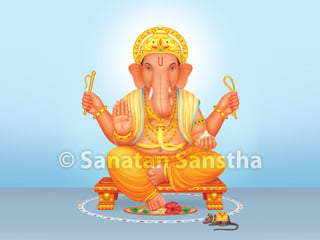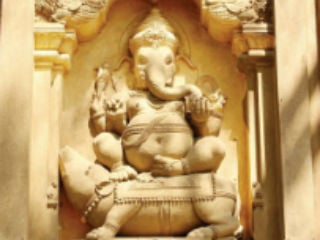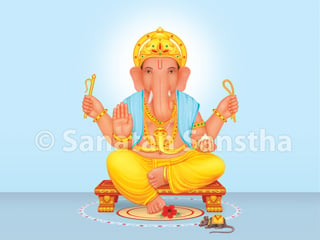
Contents –
1.1. According to Maharshi Panini
1.2 According to the Sanskrutkosh
1.3 According to the Nighantukosh
1. Origin and meaning
Gana (गण) + pati (पति)= Ganapati. Pati is the nurturer. The various meanings of the word gana are given below.
1.1. According to Maharshi Panini
Gana is a group of the eight vasus. The word vasu refers to direction or the guardian deity of the directions (dikpal or dikdev). Ganapati is the nurturer, master (swami) of the directions. (According to one school of thought, Ganapati is the master of the ten directions. The upward and downward directions along with the eight directions constitute the ten directions.) Other deities cannot reach the site of ritualistic worship (puja) from any direction without His permission. Hence any auspicious task or the ritualistic worship of any other deity is commenced with the ritualistic worship of Deity Ganapati. Once Ganapati clears the directions, the deity one is worshipping can manifest itself there. This itself is referred to as Mahadvarpujan or Mahaganapatipujan. [In the Ganpatya sect, the word Ganapati is used instead of Brahman (God) and Mahaganapati instead of Parabrahman (Supreme God).]
1.2 According to the Sanskrutkosh
Gana means a pure spiritual particle (pavitrak). A pavitrak is the subtlemost particle of divine consciousness (chaitanya). Ganapati is the master of such pure particles.
1.3 According to the Nighantukosh
Gana is the collection of tiryak (raja) and visphutit (tama) frequencies which are harmful to the animate creation. The one controlling them is Ganapati. As given in the table below, there are 360 different frequencies which travel continuously in the eight directions. A collection of these frequencies is referred to as gana. Sage Hiranyagarbha was the exponent of these frequencies. (Detailed information about the 360 and 108 frequencies is given in ‘Science of Spirituality : Vol. 7 – Supreme God, God, Incarnations and Deities’.)

 Maghi Shri Ganesh Jayanti 2025
Maghi Shri Ganesh Jayanti 2025 Sankashtnashan Stotra
Sankashtnashan Stotra Signs of ancient Hindu culture left behind in foreign lands
Signs of ancient Hindu culture left behind in foreign lands Some mantras to be recited when worshipping Shri Ganesh with specific objectives
Some mantras to be recited when worshipping Shri Ganesh with specific objectives Chants of Shri Ganesh
Chants of Shri Ganesh